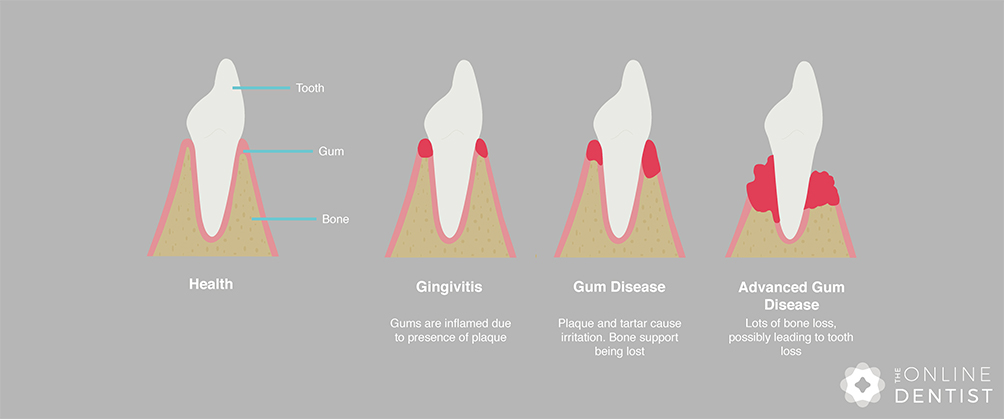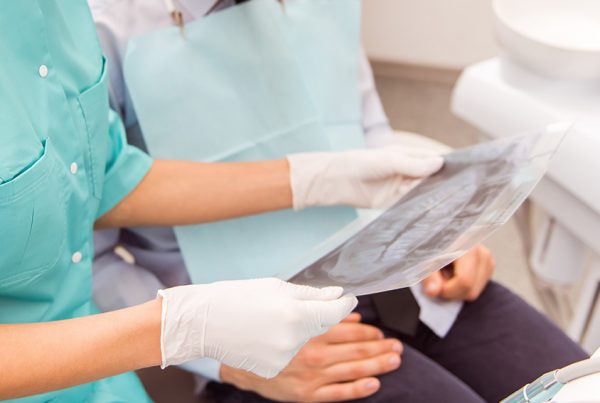In the ‘Bleeding gums’ article we talked about the two main causes of bleeding gums. They are ‘gingivitis’ and ‘gum disease’.
The difference between gingivitis and gum disease is that in gingivitis, the gum is annoyed that you haven’t been cleaning it well enough. In gum disease, the inflammation is not just affecting the gums but also the rest of the tissues that support your teeth and hold them in place. This is the bone around your teeth and the tiny ligament that holds your tooth in the socket.
In health, your gums form a sleeve around the neck of your teeth to keep plaque and food out. Disease starts when this barrier is broken and bugs can get under your gums to cause irritation and inflammation.
In gum disease, everything that supports your teeth is being irritated by these bacteria below your gum. These tissues are being eroded away gradually so that the bone around your teeth is lost.
If that bone goes then your teeth aren’t going to stay in position for very long. They are going to move and drift about. You will feel that they are wobbly. You may see gaps forming where they weren’t before. Eventually, if enough bone is lost or if you get a big flair up of infection, you will start to lose teeth.
It happens at different rates with different people. Some people aren’t really susceptible at all to gum disease. With some people it progresses really slowly and with others it happens much more quickly and aggressively. People who will be most susceptible to gum disease are diabetic patients and smokers. Diabetic patients have a dampened immune system and will find it hard to fight off the irritation being caused by bacteria. Smoking decreases the blood supply to tissues in your mouth so that, again, your body’s immune system can’t get to the area of irritation effectively because there is less blood going to the area.
Treatment; Professional Cleaning
The treatment is similar in principal to gingivitis. Gum disease is caused by bacteria causing inflammation underneath your gums. To get rid of the inflammation, the bacteria and bugs need to be cleaning away. However, because they are under your gum, it is going to be almost impossible to do it all yourself.
Professional, deep cleaning will be required.
Professional cleaning will involve gently cleaning below the gum line, flushing away bacteria and removing any hard tartar build up that may be under the gum. The idea is to try and disinfect the whole of your mouth as effectively as possible to get rid of the offending bugs.
After that, it’s down to you. Once your mouth has been thoroughly cleaned, the long term success of the treatment is in your hands. If you, as the patient, are able to then keep your teeth perfectly clean, then you are going to keep the bacteria off your teeth, prevent the disease progressing and maintain your teeth for much longer. It is so important that your cleaning is as perfect as possible after gum treatment. If it isn’t good enough then the treatment won’t work.
What if I don’t get treatment?
The consequence of ignoring gum disease is that it will eventually lead to tooth loss. Gum disease will progress at different rates for different people so it may be years and years before teeth start to be lost. I believe that it’s much better to try and treat the disease to stop it getting worse. Preventing tooth loss is much better than trying to replace the teeth when they have gone.
The other consequence of not having treatment is that these teeth are unlikely to go quietly. Before you lose the infected teeth, they are likely to get loose, painful and make eating rather uncomfortable.
Sometimes tooth loss is going to be inevitable. It’s going to happen, no matter what you do. But treatment and good cleaning on your part at home will always keep these teeth going for as long as possible.
Good news
The great thing about gum disease (I know this is a strange way to start a sentence) but the great thing is that you, as a patient, have a huge amount of control over it. If you spend the time in your daily routine to get your mouth and teeth perfectly clean at least twice a day, you will be able to halt the disease yourself.
You are going to need some professional cleans at the start and then further visits every few months to maintain things. However, ultimately the success of the treatment comes down to you and how motivated you are to save your teeth. So from that point of view, it’s fantastic. You are in control.
Periodontal Gum Treatment
Here, we have included a brief summary of the information above and also outlined what you need to know about treatment for gum disease. If you would like to know more after you have read this, there is a link to a more in-depth article below.
What is gum disease?
Gum disease is caused by the bacteria that live in your mouth. The bacteria stick to your teeth, irritate the gums and make them bleed. Gum disease can eventually destroy the gum and bone, which support your teeth.
Some people have more severe gum disease than others. This can have specific causes such as diabetes or smoking, but some people are just more susceptible to gum disease.
What is periodontal treatment?
Periodontal treatment is the deep thorough cleaning of your teeth and gums to help control the bacteria that cause gum disease.
What happens during initial periodontal treatment?
Your dentist or hygienist will remove the tartar (calculus) caused by bacteria from above the gum line by cleaning the teeth. They then remove the bacteria, loose gum tissue and tartar under the gum. This involves the use of fine powered and hand operated cleaning instruments on the tooth surfaces under local anaesthesia (making the area numb).
Gum treatment usually involves one to two appointments of deep gum cleaning. This may be followed by review appointments to monitor healing.
Following three months of healing, a reassessment appointment will
determine the extent of gum healing.
In some forms of gum disease it may be necessary to take a course of antibiotics after treatment.
What are the benefits? Why should I have periodontal treatment?
After periodontal treatment your gums will become healthier, which will help you keep your teeth for longer. This improvement will depend on how good your cleaning becomes and how severe your disease was to start with. If your gums bleed or are swollen this will reduce after treatment. If your gums are sore, treatment should help and if your teeth feel loose they may feel firmer after treatment. Your breath may be fresher.
What are the risks?
After treatment, you will experience some discomfort. This will resolve after a few days as the healing period starts and can be managed with pain killers. You are likely to experience a short term increase in sensitivity. Sensitive toothpastes can be used as a cream around the teeth to help. You may notice that your gums shrink back as the swollen and inflamed tissues heal. This shrinkage of the tissues may show in the form of recession and “black triangles” becoming visible between your teeth.
What are the alternatives?
1. No treatment. The result of not having treatment will depend on how severe your gum disease is.
You should be aware that this could have a negative effect on the prognosis of the teeth with gum disease. If gum disease is left untreated, the disease is likely to progress. This may result in tooth loss.
2. Extractions. Removal (extraction) of teeth may be an acceptable alternative treatment if your gum disease is severe. This may mean you accept spaces where tooth/teeth have been removed or have replacements with dentures, bridges or implants. However, most people find it easier and more enjoyable to eat with natural teeth than a denture.
If you would like to know more about the treatment for gum disease, please visit the article.
Keep updated with the Online Dentist newslettersign up today
Recent Articles
 Tooth decay is when you get holes (also known as cavities) in your teeth. This is caused by bacteria in plaque. It’s one of the main reasons why you need...
Tooth decay is when you get holes (also known as cavities) in your teeth. This is caused by bacteria in plaque. It’s one of the main reasons why you need...
 NB: If you come to this section in a rush because someone has knocked an adult tooth completely out, go to ‘Knocked out adult tooth’ article. Of course young children...
NB: If you come to this section in a rush because someone has knocked an adult tooth completely out, go to ‘Knocked out adult tooth’ article. Of course young children...





